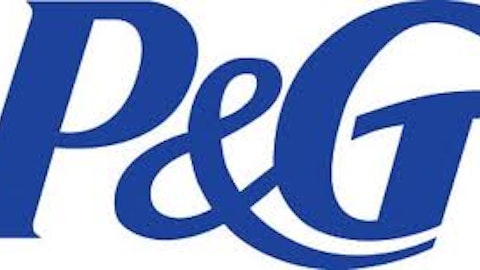Last month, I suggested that The Procter & Gamble Company (NYSE:PG) would be a good stock for a retiree’s portfolio. The company is built around a core of staple consumer brands such as Tide and Gillette, and isn’t likely to fade into obscurity anytime soon.

But the story became more interesting when, late last week, activist investor Bill Ackman was successful in ousting the company’s (now former) CEO Bob McDonald.
In a presentation early in May, Ackman argued that new management could increase the company’s earnings-per-share to $6 within the next three years. If current valuations were to hold, that would mean a share price of about $110 — more than a 30% upside from current levels.
Ackman’s case for Procter & Gamble
For curious investors, Business Insider is hosting Ackman’s slides from his presentation at Ira Sohn. But to sum up Ackman’s argument: The Procter & Gamble Company (NYSE:PG) is a great business, it has just underperformed its potential.
Throughout the presentation, Ackman referred to promises made from the former (and now current) CEO AG Lafley. When he was heading the company in 2007, Lafley promised a number of performance improvements — improvements that have yet to materialize.
For example, Lafley believed that the company should be able to increase The Procter & Gamble Company (NYSE:PG)’s gross margin from 52% (the figure back then). Today, it’s less than that — 51.2% in the first quarter. An improvement from last year, but still below the expectations Lafley had set out in 2007.
Similarly, Lafley had said to expect an operating margin of at least 24% by 2010. But The Procter & Gamble Company (NYSE:PG) reported a figure of just 21% last quarter.
In short, Ackman believes that CEO McDonald was incompetent, and that AG Lafley should be better able to deliver on the promises he made. If that’s the case, shares could have further upside from here.
Ackman believes The Procter & Gamble Company (NYSE:PG) shares could be worth $125 — but that assumes a multiple of 20, and total dividends of $5 for 2014 and 2015.
Analysts at UBS largely agree with Ackman, although they are slightly less positive on the stock’s potential. UBS upgraded Procter & Gamble to a Buy on Friday, and raised its price target to $95. They cited the return of AG Lafley as the primary catalyst.
J.C. Penney Company, Inc. (NYSE:JCP) or Canadian Pacific Railway Limited (USA) (NYSE:CP)?
The Procter & Gamble Company (NYSE:PG) isn’t the first firm to hire a new CEO after Ackman began pushing for a change. In recent years, Ackman has driven out the former CEOs of both J.C. Penney Company, Inc. (NYSE:JCP) and Canadian Pacific Railway Limited (USA) (NYSE:CP) — but what followed couldn’t have been more different.
Canadian Pacific Railway Limited (USA) (NYSE:CP) has been an amazing success story — shares of the railroad giant are up nearly 90% since Hunter Harrison was named CEO last year. Ackman’s fund, Pershing Square, had to fight a proxy contest to get Harrison appointed CEO.
In the run-up to the proxy vote, Ackman gave a presentation in which he blamed nearly all of Canadian Pacific Railway Limited (USA) (NYSE:CP)’s problems on its then current management, and in particular, its CEO Fred Green.
Evidently, Ackman was on to something, as Harrison has so far delivered strong results on the job, including the company’s best first quarter earnings report ever.
As of the end of March, Pershing Square remains heavily invested in Canadian Pacific — in fact, it’s the fund’s largest holding, representing almost one-third of Pershing Square’s capital. During the original proxy contest, Ackman noted that Pershing tends to hold its investments for roughly four years.
But as good of an investment as Canadian Pacific has been, J.C. Penney Company, Inc. (NYSE:JCP) has been equally as bad. Since Ron Johnson took over late in 2011, shares of the retailer are down over 40%.
Unlike Hunter Harrison who had a distinguished railroad career, Johnson was not experienced when it came to selling clothing. Although his strategy worked marvelously when he was selling iPhones and Macs, his ideas about pricing and advertising turned away many of J.C. Penney’s key customers.
Now, J.C. Penney Company, Inc. (NYSE:JCP) has turned to Mike Ullman, the CEO Ackman ousted in the first place. Although Pershing Square has yet to publicly comment on Ullman’s qualifications, there has been speculation that Ackman was trying to find a replacement. However, The New York Post reports that Ackman has lost his influence on the board, which has decided to stick with Ullman for the foreseeable future.
At any rate, Ackman has said he intends to keep his investment in the retailer.
Investing in The Procter & Gamble Company (NYSE:PG)
Given that AG Lafley was himself a former successful Procter & Gamble CEO, I think it’s more probable that the consumer giant will turn out like Canadian Pacific rather than J.C. Penney Company, Inc. (NYSE:JCP).
Lafley won’t be undertaking a radical redesign of Procter & Gamble, just attempting to improve the company’s performance.
With a roughly 3% dividend yield and a solid portfolio of dozens of products people consume every day, Procter & Gamble remains a fairly safe stock. Even if Lafley fails to generate the performance improvements he had promised, shares are not likely to experience a significant decline, baring a market selloff.
Ultimately, Procter & Gamble remains a boring stock, but it has an interesting upside.
The article Procter & Gamble: 34% Upside With Little Risk? originally appeared on Fool.com is written by Salvatore “Sam” Mattera.
Joe Kurtz owns shares of J.C. Penney Company. The Motley Fool recommends Procter & Gamble. Salvatore “Sam” is a member of The Motley Fool Blog Network — entries represent the personal opinion of the blogger and are not formally edited.
Copyright © 1995 – 2013 The Motley Fool, LLC. All rights reserved. The Motley Fool has a disclosure policy.

